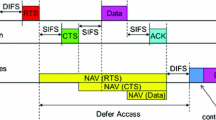Abstract
In this paper, we estimated the influence of capture effect over the capacity of IEEE 802.11b DCF within a single picocell. The channel utilization is examined analytically by introducing two capture models based on Rayleigh-distributed envelopes of the captured and the interfering frames divided into two local-mean power classes. Simulations in a pure Rician-faded channel depict the conditions under which both Rayleigh-faded capture models can be used to accurately predict the peak network capacity. Unlike the RTS/CTS “handshake” access mode, Basic access mode is significantly sensitive to the capture ratio, i.e., the receiver design. The packet size threshold over which it is convenient to switch from Basic to RTS/CTS “handshake” access scheme is also sensitive to the capture effect.
Similar content being viewed by others
REFERENCES
J. J. Matzner, “On Improving Utilization in ALOHA Networks,” IEEE Trans. on Commun., Vol. COM-24, pp. 447–448, Apr. 1976.
C. Arnbak and W. van Blitterswijk, “Capacity of Slotted Aloha in Rayleigh-Fading Channels,” IEEE J. Select. Areas Commun., Vol. SAC-5, pp. 261–269, Feb. 1987.
C. T. Lau and C. Leung. “Capture Models for Mobile Packet Radio Networks,</del>,” IEEE Trans. On Commun.,Vol. COM-40, pp. 917–925, May 1992.
M. Zorzi and R. R. Rao, “Capture and Retransmission Control in Mobile Radio,” IEEE J. Select. Areas Commun., Vol. 12, No. 8, pp. 1289–1298, Oct. 1994.
R. O. LaMaire, A. Krishna, and H. Ahmadi, “Analysis of aWireless MAC Protocol with Client-Server Traffic and Capture,” IEEE J. Select. Areas Commun., Vol. 12, pp. 1299–1313, Oct. 1994.
A. Zahedi and K. Pahlavan, “Natural Hidden Terminal and the Performance of the Wireless LANs,” Proc. IEEE 6th Int. Conf. Univ. Pers. Commun., pp. 929–933, 1997.
IEEE Standard for Wireless LAN Medium Access Control and Physical Layer Specifications, IEEE 802.11b, Nov. 1999.
Z. Hadzi-Velkov and B. Spasenovski, “Capture Effect in IEEE 802.11 Wireless LANs,” Proc. IEEE ICWLHN 2001, pp. 164–173, Singapore, Dec. 5-7, 2001.
J. Bianchi, “Performance Analysis of IEEE 802.11 Distributed Coordination Function,” IEEE J. Select. Areas Commun., Vol. 18, No. 3, pp. 535–547, March 2000.
Z. Hadzi-Velkov and B. Spasenovski, “IEEE 802.11 DCF with Capture over Rician-Fading Channel,” Proc. 3rd IEEE Workshop, WLANs, Boston, USA, Sept. 27-28, 2001.
J. Perez-Romero, L. G. Alonso and R. Agusti, Average “Block Error Probability in reverse Link of a Packet DS/CDMA System under Rayleigh Fading Channel Conditions,” IEEE Commun. Letters, Vol. 4, No. 4, 116–118, April 2000.
D. Dardari, V. Tralli, and R. Verdone, “On the Capacity of Slotted Aloha with Rayleigh Fading: The Role Played by the Number of Interferes,” IEEE Commun. Letters, Vol. 4, No. 5, pp. 155–157, May 2000.
Author information
Authors and Affiliations
Rights and permissions
About this article
Cite this article
Hadzi-Velkov, Z., Spasenovski, B. On the Capacity of IEEE 802.11 DCF with Capture in Multipath-Faded Channels. International Journal of Wireless Information Networks 9, 191–199 (2002). https://doi.org/10.1023/A:1016037711861
Issue Date:
DOI: https://doi.org/10.1023/A:1016037711861




